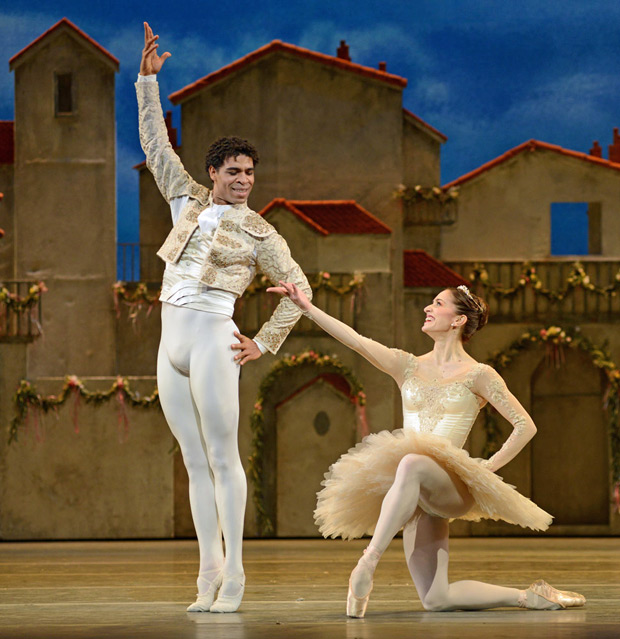
© Dave Morgan, courtesy the Royal Opera House. (Click image for larger version)
The Royal Ballet
Don Quixote
Washington, Kennedy Center Opera House
9, 13 June 2015
Gallery of pictures by Dave Morgan
www.roh.org.uk
www.kennedy-center.org
After a six-year absence, the Royal Ballet was back in Washington D.C. in June with its new production of Don Quixote – a ballet of slapstick comedy and technical fireworks and an undying staple of 19th-century classical repertory, based on the incidents from Cervantes’ famous novel, originally set to dance by Marius Petipa.
This handsome and highly-entertaining production is by Carlos Acosta, who attempted to breathe new life into the old and tired story about the improbable sadventures of the delusional knight and the romantic quest of the two lovers, Basilio, a poor barber from Barcelona, and his love interest, Kitri, to secure their “happily-ever-after.” With clever theatrical touches and novel ideas, Acosta jazzed up the action, bringing it closer to modern times. He spiced the outlandish narrative with drama; enlivened the crowd scenes; gave more prominence to character dancing; and, most importantly, he imbued the title character with passion and respect, giving the eccentric Don Quixote a true human dimension, thus turning him from an old fool (as most productions tend to portray him) into a lovable, genuine character and an active participant in the story.
This production is perfectly tailored for the company and manages to squeeze from the silly plot its full entertainment value.

© Dave Morgan, by kind permission of the Royal Opera House. (Click image for larger version)
On opening night, when Acosta strode onstage, a guitar in hand, as the fun-loving Basilio, the audience erupted with applause, awarding the Cuban-born dancer a genuine hometown-hero welcome.
At 42, Acosta is still a powerful presence. A much-loved artist around the world, he is undoubtedly one of the greatest male dancers of his generation. He inhabited the role of the good-natured Basilio to the fullest. Charming and dashing, his unforgettable smile lighting up every scene he was in, Acosta delivered a master class in physical comedy and classical dancing. His technique is still strong and imposing, even if he no longer possesses the same phenomenal elevation and lightness in his jumps that he once did. His acting and timing were spot-on as he portrayed the cheerful barber, who happened to set his eyes and his heart on a tough-to-get but worthy catch – Kitri, the beautiful young daughter of Lorenzo, the town’s innkeeper.
We all felt what the guy was going through. It was impossible not to fall in love with Marianela Nuñez’s Kitri, for she was a marvel of comic and technical brilliance at every turn, capturing Bacilio’s heart – as well as ours – at the first snap of her fan. She was gorgeous and charming and strong-willed – a darling sweetheart, an independent spirit and also an impossible flirt, changing from cold to hot and back in an instant. At one moment, she hardly looked at her admirer; then, almost immediately, she melted him with her adoring gaze, teasing the life out of Acosta’s Basilio, who, in turn, teased her right back.

© Dave Morgan, by kind permission of the Royal Opera House. (Click image for larger version)
Both dancers played their roles to the hilt. Their chemistry was palpable and infections, and the romantic attraction of their characters was undeniable – an ideal partnership in rapport, energy and spirit. You believed in their characters’ story; you rooted for their happiness.
And what a fascinating dancer Nuñez is! I admired the wealth of nuances with which she colored her part. She effectively used her beautiful shoulders – she did it with just a subtle shrug, really – to express a universe of emotions from playful annoyance to alluring invitation, wonderfully balancing stormy, sweet and sexy. Her technical prowess is impeccable and this role gives her plenty of moments to shine in a diverse range of choreographic styles. A prodigious allegro ballerina, she was thrilling as she stabbed the floor with her sharp, perfectly-articulated points, her fan rippling the air with tantalizing madness. Her jumps were light, buoyant and airy. She revealed her lyrical side in a sensual, sunset-inspired romantic duet in the second act, swaying to and fro in the gentle hands of her lover; and her turn in the famous grand pas of the final act was pure joy.
The Saturday evening cast was led by Matthew Golding as Basilio and Sarah Lamb as Kitri. This was a technically notable performance – the dancers effortlessly sailed through all the bravura hurdles of the choreography with spectacular abandon. Lamb’s footwork was crisp and clear; her pirouettes fast and furious. Golding was an exceptional turner, and his jumps made the audience gasp. The pair had tremendous fun in the wedding pas de deux, putting on a breathtaking display of virtuoso dancing; but they couldn’t match the theatrical ardor of the opening night couple. Lamb overplayed the comic nuances of her role, looking either too stern or too pouty. Golding, with his good looks and a nice-guy demeanor, seemed like a perfect choice for the kind-hearted Basilio, yet his characterization felt bland and I didn’t feel any romantic sparks between the two leads.

© Dave Morgan, courtesy the Royal Opera House. (Click image for larger version)
Still, there was so much to admire during the Saturday-night performance. The ensemble dancing was markedly better: the gypsy dancers brought real verve and fire into their gathering; the team of matadors, in flame red, danced with more polish and assurance; and even the third act’s duel between Gamache and Don acquired a nice comic zest. The definite highlight was the impeccably rendered vision scene in the garden of the Dryads, led by Lamb, Fumi Kaneko as the Queen of the Dryads and Francesca Hayward as Amour. The whole scene was so spectacularly danced that even the horrid, over-sized purple flowers of the décor no longer looked frightening.
Christopher Saunders (opening night) and Gary Avis (Saturday) played the titular hero with an appealing air of dignity and pathos. This production keeps the Don busy from start to finish. In the opening prologue, dressed in a comfortable plush robe, he gets a chance to meet the lady of his dreams, Dulcinea, who knights him with his sword and inspires his future chivalric journey, thus giving a logical narrative arc to the events to come.
On opening night, Laura Morera was impressively lively as the street dancer Mercedes; Ryoichi Hirano shone as a famous matador Espada; and Itziar Mendizabal and Thomas Whitehead ignited quite a few erotic sparkles as the hot-tempered gypsy couple.
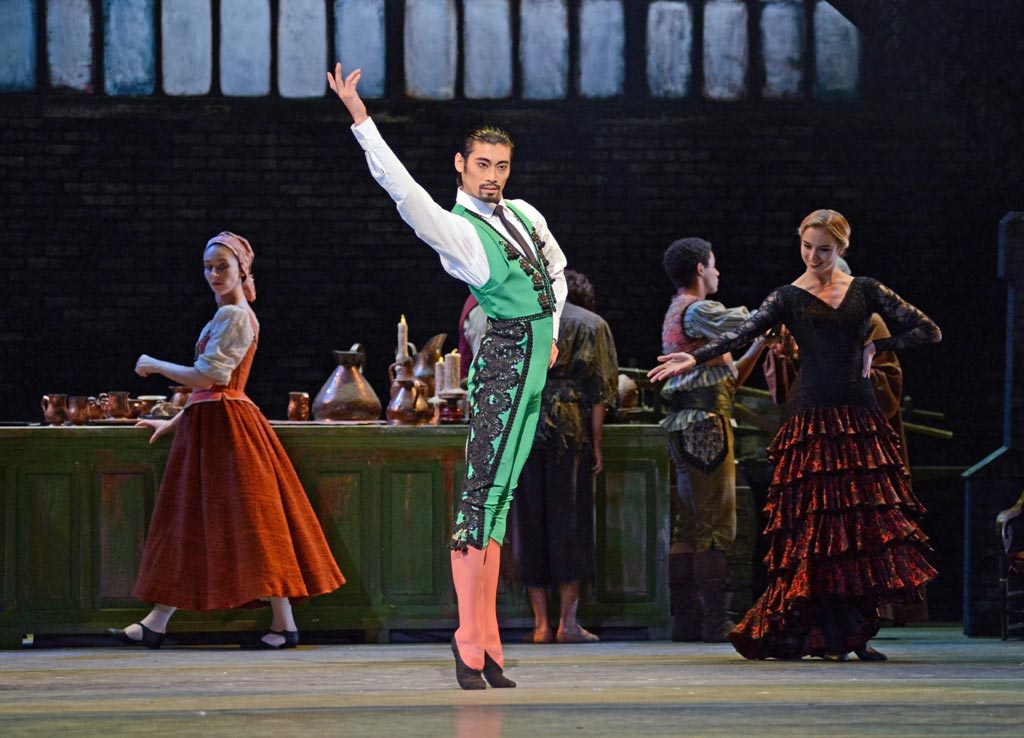
© Dave Morgan, by kind permission of the Royal Opera House. (Click image for larger version)
On Saturday, Hirano gave up his bright green matador costume for a powdered wig and flamboyant feather hat, playing with a fantastic comic zeal the role of a rich nobleman Gamache, Kitri’s unfortunate suitor. Alastair Marriott made for a goofy and laidback Lorenzo, Kitri’s overbearing father. His long hair and unkempt beard made me think that getting a barber as a son-in-law would not be a bad outcome for him after all.
For the most part, this production is a visual delight. Designer Tim Hatley sets the story in a picturesque town of white houses with red roofs under a warm, gloriously-blue sky. The homes move in and out of the way, changing the scenes and advancing the plot. The eponymous windmill in the second act impressively grows – like Clara’s Christmas tree – to ignite the Don’s imagination and to knock the fun out of him. And an impressive giant straw horse, Rocinante, affords the Don a memorable way to enter and exit this story. The ballet ends with a poignant image: the townsfolk and newlyweds, Kitri and Basilio, wave and bid farewell to the Don and his faithful sidekick, Sancho, as they leave town, riding into the unknown. Let’s hope this Don Quixote lives and travels well.











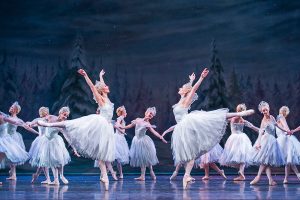
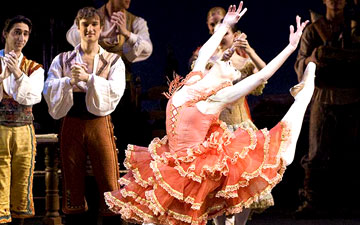
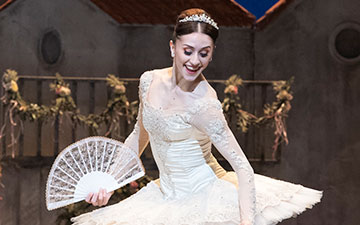
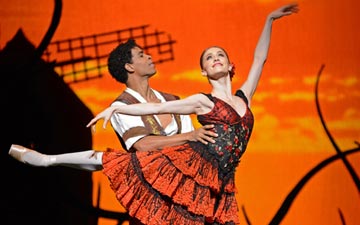
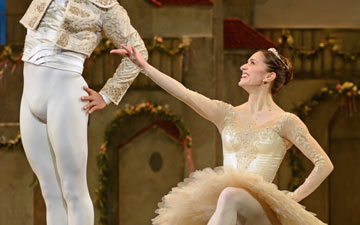

You must be logged in to post a comment.